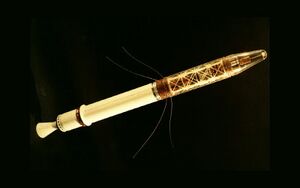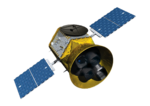Astronomy:Explorer 5
From HandWiki
Short description: United States satellite launched in 1958
 Explorer 5 before launch. | |
| Mission type | Earth science |
|---|---|
| Operator | Army Ballistic Missile Agency |
| Mission duration | Failed to orbit |
| Spacecraft properties | |
| Manufacturer | Jet Propulsion Laboratory |
| Launch mass | 16.86 kilograms (37.2 lb) |
| Start of mission | |
| Launch date | August 24, 1958, 06:17:22 UTC |
| Rocket | Juno I |
| Launch site | Cape Canaveral Air Force Station Cape Canaveral Air Force Station Launch Complex 5 |
| Orbital parameters | |
| Reference system | Geocentric |
| Regime | Medium Earth |
| Epoch | Planned |
Explorer program | |
Explorer 5 was a United States satellite with a mass of 17.24 kg. It was the last of the original series of Explorers built, designed, and operated by the Jet Propulsion Laboratory.[1]
It launched atop a Juno I rocket on August 24, 1958 from Cape Canaveral Air Force Station Launch Complex 5 , but failed when the rocket's first stage collided with its second stage after separation, causing the upper stage firing angle to be off.[2]
Explorer 5 had been intended to be one of two satellites used to gather data for Project Argus.
References
- ↑ Jet Propulsion Laboratory, "Explorer 5"
- ↑ "Past Missions - Explorer 1-5". Jet Propulsion Laboratory. http://www2.jpl.nasa.gov/missions/past/explorer.html. Retrieved 2008-02-03.


